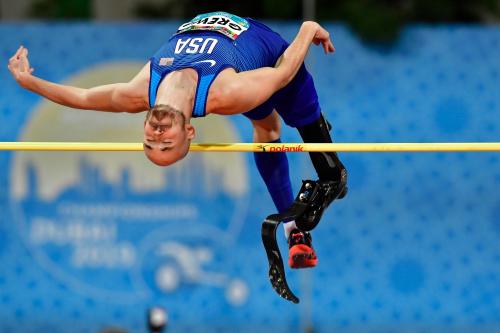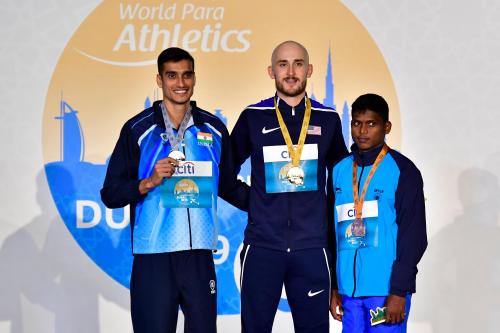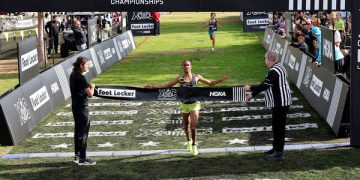Sharad Kumar (India) 1.83m, silver, Sam Crewe (USA) 1.86m, gold, Mariv Thangavelu (India) 1.80, bronze, photo and copyright by IPC
This is Stuart Weir’s piece on the one legged high jump…
The one-legged high jump
Someone once wrote: “We should not ask why the one-legged man decided to try the high jump; we should just be glad that he did”. The T63 high jump is arguably the most compelling event in the para athletics program. The definition of T63 is: “Athletes with single through knee or above knee limb deficiency competing with a prosthesis where minimum impairment criteria for lower limb deficiency are met”. But that competition also includes T42 “Athletes have one or more impairment types affecting hip and/or knee function in one or both limbs and with activity limitations in throws, jumps and running competing without prosthesis/prostheses comparable to that of an athlete with at least a single through or above knee amputation. Athletes with impairment(s) roughly comparable to bilateral above knee amputations are also placed in this class”.
So you have a group of male amputees and others with legs that don’t work normally doing the high jump. Some jump with a running blade. Some remove their prosthetic and hop to the bar and hurl themselves over. Those with two legs limp towards the bar and leap over it. Some go over the bar head first, effectively diving. Others use a more conventional approach.
The results were
1 Sam Crewe (USA) 1.86m
2 Sharad Kumar (India) 1.83m
3 Mariv Thangavelu (India) 1.80
 Sam Crewe, photo and copyright by IPC
Sam Crewe, photo and copyright by IPC
Sam Crewe told me afterwards: “Tonight was definitely a shaky competition for me. I have had much better competitions previously but with a gold medal at the world championship I can’t even begin complaining. To be the champion having had an off day is incredible and to be going into Tokyo next year”. When I suggested that it was an amazing event, Crewe agreed: “It is. That’s what drew me to it in the first place. There are four or five different styles of jumping because it so versatile and everyone has their own challenges and issues. So, everyone adapts to what they’re good at and works on what they struggle with. What attracted me was knowing that if something isn’t working, I can always change it. And I think people are just fascinated by the amputee high jump, seeing the running blades in action or people just hopping over but jumping effectively over a height as high as most people’s head. It just relates to everyone as inspiring”.
 Sharad Kumar, photo and copyright by IPC
Sharad Kumar, photo and copyright by IPC
Silver medallist, Kumar, enthused afterwards: “The on- legged high jump is the best experience to do – or watch. If you haven’t seen it you need to catch up. For a person with one leg to be jumping nearly two meters is defying the human body and yet we only have a handful of people watching us, just our own people. I think people need to be educated more and if they call themselves educated, they need to learn more”. Explaining his background, he said: “I started training when I was seven years old and have been doing high jump for 15 years. I started in a boarding school. In the school, sport and education went hand in hand. If you were not good at both of them you left the school! I also played cricket and table tennis. At boarding school you do a lot of sport you are jacks of all trades and may be master of one”.
While Crewe referred to the four or five different styles of jumping, he has only used one: “I’ve never tried without my blade on because I wasn’t coached that way. I’ve always trained with athletes with two legs. I’m on the university track team and I am coached the same as any of those athletes. It works for me so I’ve never considered changing it but if it hadn’t worked for me it would have chosen a different way”. Kumar agreed: “When you start with one style you tend to carry on with it because that’s how you start eroding your fears. We all have certain restrictions and have to do what our body allows”.
I would have loved to have spoken to every athlete in the event to understand more of this amazing discipline. It is a compelling spectacle, an event with combined great skill and raw courage. It is the essence of para athletics.
Author

Since 2015, Stuart Weir has written for RunBlogRun. He attends about 20 events a year including all most global championships and Diamond Leagues. He enjoys finding the quirky and obscure story.
View all posts


















